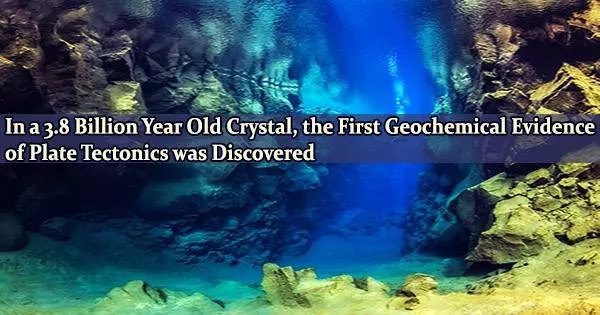According to a new study published today in AGU Advances, the organization’s journal for high-impact, open-access research and commentary across the Earth and space sciences, a few ancient zircon crystals discovered in South Africa contain the earliest proof of subduction, a crucial component of plate tectonics.
The change from a long-lived, stable rock surface to the active processes that create our planet today occurred roughly 3.8 billion years ago, according to these unique time capsules from Earth’s early history, offering a fresh insight into the contentious question of when plate tectonics began.
The top layer of the mantle that lies immediately beneath the crust of the Earth is divided into stiff plates that move slowly on top of the viscous yet moveable lower layers of mantle rock. Volcanoes, earthquakes, and mountain range uplift are all caused by this slow but inevitable motion, which is propelled by heat from the Earth’s core.
Between nearly 4 billion years ago and only 800 million years ago, according to estimates, this process picked up and the present crust began to develop. Due to the surface recycling result of plate tectonics itself, there is uncertainty because the geologic record from Earth’s early history is scant. Almost nothing remains from the Hadean Eon, Earth’s first 500 million years.
“The Hadean Earth is this big mystery box,” said Nadja Drabon, a geologist at Harvard University and the lead author of the new study.
Tiny time capsules
Drabon and her colleagues made an exciting breakthrough in the investigation of this mystery in 2018 when they discovered a chronological series of 33 microscopic zircon crystals that were formed over an important 800-million-year time period, from 4.15 to 3.3 billion years ago, in a rare, ancient block of crust in the Barberton Greenstone Belt in South Africa.
When I say plate tectonics, I’m specifically referring to an arc setting, when one plate goes under another and you have all that volcanism think of the Andes, for example, and the Ring of Fire. At 3.8 billion years there is a dramatic shift where the crust is destabilized, we have new rocks forming and we see geochemical signatures becoming more and more similar to what we see in modern plate tectonics.
Nadja Drabon
Zircon is a fairly common auxiliary mineral in the crust of the Earth, but old samples from the Hadean Eon, 4 to 4.56 billion years ago, are incredibly rare, occurring in only 12 spots on Earth and typically in quantities of fewer than three at each location.
The hafnium isotopes and trace elements found in the zircons of the Greenstone Belt provided information on the climate on Earth at the time of their crystallization. Zircons that are 3.8 billion years old and younger seem to have developed in rock that was subjected to pressures and melting akin to those found in present subduction zones, indicating that the crust may have begun to move.
“When I say plate tectonics, I’m specifically referring to an arc setting, when one plate goes under another and you have all that volcanism think of the Andes, for example, and the Ring of Fire,” Drabon said, describing a classic example of subduction.
“At 3.8 billion years there is a dramatic shift where the crust is destabilized, we have new rocks forming and we see geochemical signatures becoming more and more similar to what we see in modern plate tectonics,” Drabon said.
The study discovered that earlier zircons had maintained proof of a worldwide cap of “protocrust” made of remelting mantle rock that had been stable for 600 million years.
Signs of global change
In zircons from other parts of the planet, dating to within around 200 million years of the South African zircons, the new study discovered a similar transition to conditions approximating present subduction.
“We see evidence for a significant change on the Earth around 3.8 to 3.6 billion years ago and evolution toward plate tectonics is one clear possibility,” Drabon said.
While not conclusive, the results suggest a global change may have begun, Drabon said, possibly starting and stopping in scattered locations before settling into the efficient global engine of constantly moving plates we see today.
Along with its surface, the Earth’s atmosphere is shaped by plate tectonics. Large temperature swings caused by too much or too little greenhouse gas are tempered by the release of volcanic gasses and the formation of new silicate rock, which absorbs significant amounts of carbon dioxide from the atmosphere.
“Without all of the recycling and new crust forming, we might be going back and forth between boiling hot and freezing cold,” Drabon said. “It’s kind of like a thermostat for the climate.”
Plate tectonics has, so far, only been observed on Earth, and may be essential to making a planet livable, Drabon said, which makes the origins of plate motions of interest in research into the early development of life.
“The record we have for the earliest Earth is really limited, but just seeing a similar transition in so many different places makes it really feasible that it might have been a global change in crustal processes,” Drabon said. “Some kind of kind of reorganization was happening on Earth.”





